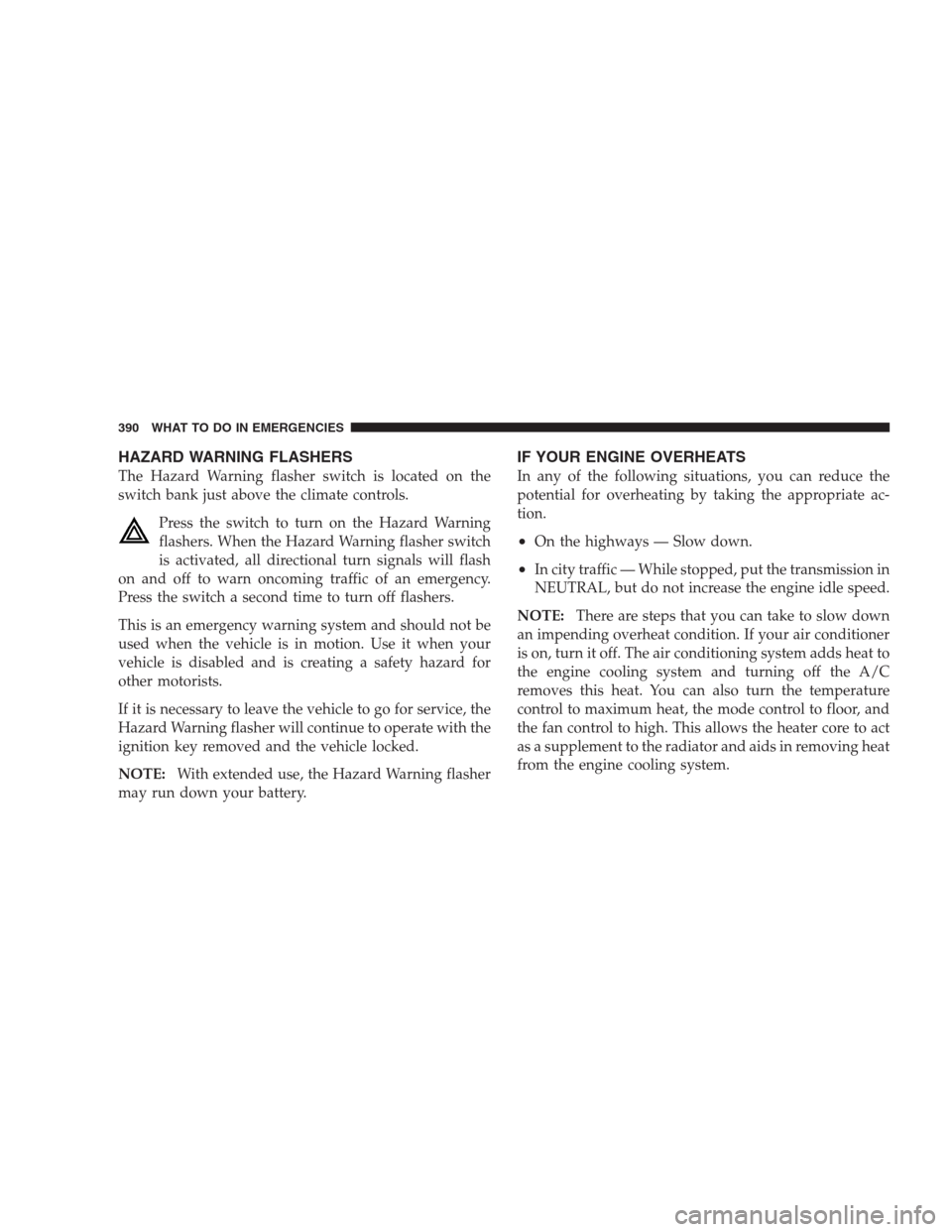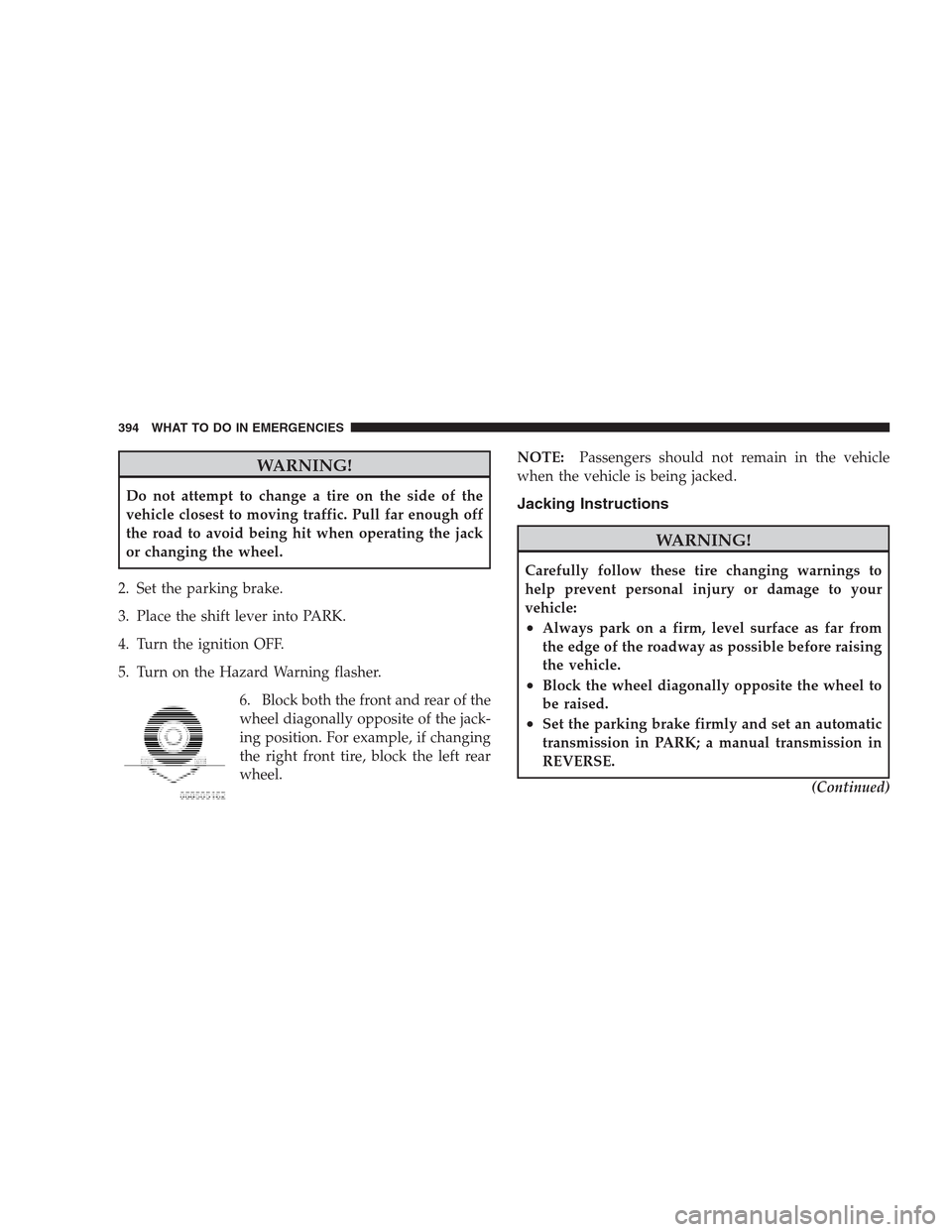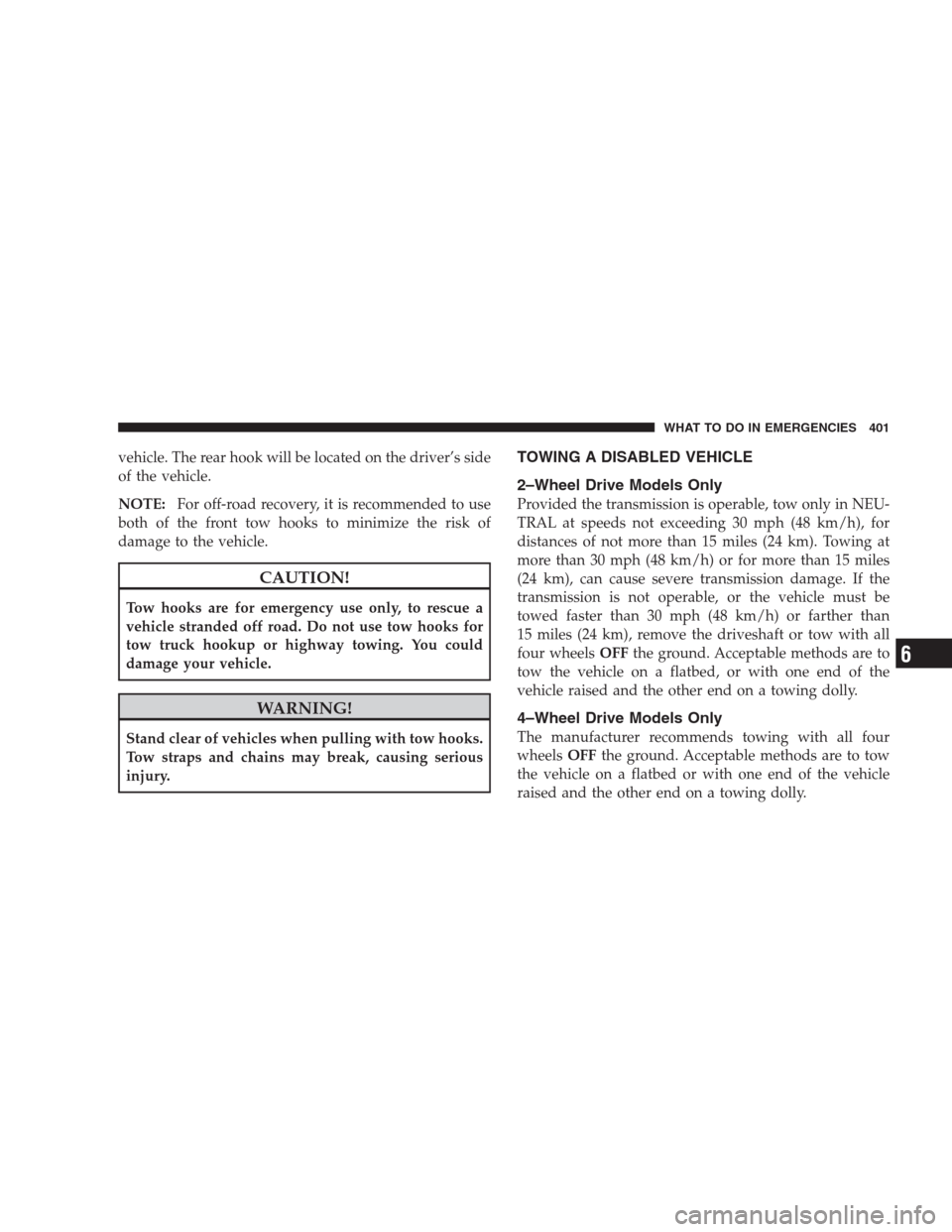Page 387 of 521
9. Shift the transmission into PARK.
10. Place the ignition key in the OFF position, and
remove key.
11. Apply the parking brake.
12. Attach the vehicle to the tow vehicle with tow bar.
13. Release the parking brake.
CAUTION!
Transmission damage may occur if the transmission
is shifted into PARK with the transfer case in NEU-
TRAL and the engine running. With the transfer case
in NEUTRAL ensure that the engine is OFF prior to
shifting the transmission into PARK (refer to steps 7
and 8 above).
Shifting Out Of NEUTRAL
Use the following procedure to prepare your vehicle for
normal usage.
1. Depress the brake pedal.
2. Turn the ignition key ON, engine off.
3. Shift the transmission into NEUTRAL.
4. Shift the transfer case out of NEUTRAL.
STARTING AND OPERATING 385
5
Page 388 of 521
Hold down the NEUTRAL “pin” switch (with a pen, etc.)
for four seconds until the LED lamp by the switch starts
to blink, indicating shift in progress. The lamp will stop
blinking (go out) when shift is complete. The “4WD
SYSTEM IN NEUTRAL” message will no longer be
displayed on the EVIC (Electronic Vehicle Information
Center). Refer to “Electronic Vehicle Information Center
(EVIC)” in Section 4 of this manual.
5. Shift the transmission into PARK.
6. Start the engine.
7. Shift the transmission into DRIVE.
Neutral Switch
386 STARTING AND OPERATING
Page 389 of 521
NOTE:When shifting out of transfer case NEUTRAL,
turning the engine OFF may be required to avoid gear
clash.
WARNING!
You or others could be injured if you leave the
vehicle unattended with the transfer case in the
NEUTRAL position without first fully engaging the
parking brake. The transfer case NEUTRAL position
disengages both the front and rear driveshafts from
the powertrain and will allow the vehicle to move
even if the transmission is in PARK. The parking
brake should always be applied when the driver is
not in the vehicle.
CAUTION!
Do not use a bumper-mounted clamp-on tow bar on
your vehicle. The bumper face bar will be damaged.
STARTING AND OPERATING 387
5
Page 392 of 521

HAZARD WARNING FLASHERS
The Hazard Warning flasher switch is located on the
switch bank just above the climate controls.
Press the switch to turn on the Hazard Warning
flashers. When the Hazard Warning flasher switch
is activated, all directional turn signals will flash
on and off to warn oncoming traffic of an emergency.
Press the switch a second time to turn off flashers.
This is an emergency warning system and should not be
used when the vehicle is in motion. Use it when your
vehicle is disabled and is creating a safety hazard for
other motorists.
If it is necessary to leave the vehicle to go for service, the
Hazard Warning flasher will continue to operate with the
ignition key removed and the vehicle locked.
NOTE:With extended use, the Hazard Warning flasher
may run down your battery.
IF YOUR ENGINE OVERHEATS
In any of the following situations, you can reduce the
potential for overheating by taking the appropriate ac-
tion.
•On the highways — Slow down.
•In city traffic — While stopped, put the transmission in
NEUTRAL, but do not increase the engine idle speed.
NOTE:There are steps that you can take to slow down
an impending overheat condition. If your air conditioner
is on, turn it off. The air conditioning system adds heat to
the engine cooling system and turning off the A/C
removes this heat. You can also turn the temperature
control to maximum heat, the mode control to floor, and
the fan control to high. This allows the heater core to act
as a supplement to the radiator and aids in removing heat
from the engine cooling system.
390 WHAT TO DO IN EMERGENCIES
Page 396 of 521

WARNING!
Do not attempt to change a tire on the side of the
vehicle closest to moving traffic. Pull far enough off
the road to avoid being hit when operating the jack
or changing the wheel.
2. Set the parking brake.
3. Place the shift lever into PARK.
4. Turn the ignition OFF.
5. Turn on the Hazard Warning flasher.
6. Block both the front and rear of the
wheel diagonally opposite of the jack-
ing position. For example, if changing
the right front tire, block the left rear
wheel.NOTE:Passengers should not remain in the vehicle
when the vehicle is being jacked.Jacking Instructions
WARNING!
Carefully follow these tire changing warnings to
help prevent personal injury or damage to your
vehicle:
•Always park on a firm, level surface as far from
the edge of the roadway as possible before raising
the vehicle.
•Block the wheel diagonally opposite the wheel to
be raised.
•Set the parking brake firmly and set an automatic
transmission in PARK; a manual transmission in
REVERSE.
(Continued)
394 WHAT TO DO IN EMERGENCIES
Page 401 of 521

WARNING!
•Battery fluid is a corrosive acid solution; do not
allow battery fluid to contact eyes, skin or cloth-
ing. Do not lean over a battery when attaching
clamps or allow the clamps to touch each other. If
acid splashes in eyes or on skin, flush contami-
nated area immediately with large quantities of
water.
•A battery generates hydrogen gas which is flam-
mable and explosive. Keep flame or spark away
from the vent holes.
•Do not use a booster battery or any other booster
source that has a greater than 12-Volt system, i.e.
Do not use a 24-Volt power source.
1. Remove all metal jewelry such as watch bands or
bracelets, which might make an unintended electrical
contact.2. Park the booster vehicle within cable reach but with-
out letting the vehicles touch. Set the parking brake on
both vehicles, place the transmission in PARK, and turn
the ignition OFF.
3. Turn off the heater, radio, and all unnecessary electri-
cal loads.
4. Connect one end of a jumper cable to the positive
terminal of the booster battery. Connect the other end of
the same cable to the positive terminal of the discharged
battery.WARNING!
Do not permit vehicles to touch each other as this
could establish a ground connection, and personal
injury could result.
WHAT TO DO IN EMERGENCIES 399
6
Page 403 of 521

vehicle. The rear hook will be located on the driver’s side
of the vehicle.
NOTE:For off-road recovery, it is recommended to use
both of the front tow hooks to minimize the risk of
damage to the vehicle.
CAUTION!
Tow hooks are for emergency use only, to rescue a
vehicle stranded off road. Do not use tow hooks for
tow truck hookup or highway towing. You could
damage your vehicle.
WARNING!
Stand clear of vehicles when pulling with tow hooks.
Tow straps and chains may break, causing serious
injury.
TOWING A DISABLED VEHICLE
2–Wheel Drive Models Only
Provided the transmission is operable, tow only in NEU-
TRAL at speeds not exceeding 30 mph (48 km/h), for
distances of not more than 15 miles (24 km). Towing at
more than 30 mph (48 km/h) or for more than 15 miles
(24 km), can cause severe transmission damage. If the
transmission is not operable, or the vehicle must be
towed faster than 30 mph (48 km/h) or farther than
15 miles (24 km), remove the driveshaft or tow with all
four wheelsOFFthe ground. Acceptable methods are to
tow the vehicle on a flatbed, or with one end of the
vehicle raised and the other end on a towing dolly.
4–Wheel Drive Models Only
The manufacturer recommends towing with all four
wheelsOFFthe ground. Acceptable methods are to tow
the vehicle on a flatbed or with one end of the vehicle
raised and the other end on a towing dolly.
WHAT TO DO IN EMERGENCIES 401
6
Page 406 of 521

▫Exhaust System..................... 422
▫Cooling System..................... 424
▫Brake System....................... 430
▫Front/Rear Axle Fluid................. 431
▫Transfer Case....................... 432
▫Automatic Transmission............... 433
▫Maintenance After Off-Road Driving...... 436
▫Appearance Care And Protection From
Corrosion.......................... 436
�Fuses.............................. 441
▫Interior Fuses....................... 441
▫Underhood Fuses (Power Distribution
Center)........................... 444▫Underhood Fuses
(Integrated Power Module)............. 447
�Vehicle Storage....................... 448
�Replacement Bulbs.................... 449
�Bulb Replacement..................... 450
▫High Intensity Discharge Headlights (HID)
— If Equipped...................... 450
▫Headlight.......................... 451
▫Front Turn Signal.................... 452
▫Front Fog Light..................... 453
▫Rear Tail, Stop, Turn Signal, And Backup
Lights............................ 454
▫Center High-Mounted Stop Light (CHMSL) . . 455
404 MAINTAINING YOUR VEHICLE